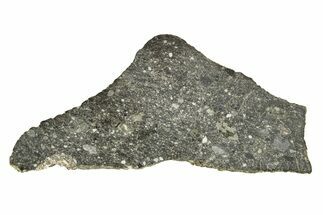2.61" Lunar Meteorite (6.59 g) Thin Slice - NWA 11182
This is a 2.61" wide (6.59 gram) thin slice of the lunar meteorite, NWA 11182.
About Lunar Meteorite - NWA 11182
Northwest Africa 11182 (NWA 11182) is a lunar meteorite classified as a feldspathic breccia. Discovered in Northwest Africa, this single 60-gram stone was purchased in 2017 at the Tucson Gem and Mineral Show. Subsequently a small amount of additional material from this same fall was recovered.
Upon examination, NWA 11182 reveals a fragmental breccia structure, characterized by numerous white feldspathic clasts and fine-grained lithic fragments embedded in a dark-gray groundmass. The meteorite exhibits areas of shock melt, some containing vesicles, indicative of significant impact events on the lunar surface.
LPI.USRA.EDU
Notably, NWA 11182 stands out among lunar meteorites for its aesthetic appeal. While many lunar breccias predominantly display shades of white, gray, and black, this meteorite features additional hues of brown, red, and deep maroon.
Northwest Africa 11182 (NWA 11182) is a lunar meteorite classified as a feldspathic breccia. Discovered in Northwest Africa, this single 60-gram stone was purchased in 2017 at the Tucson Gem and Mineral Show. Subsequently a small amount of additional material from this same fall was recovered.
Upon examination, NWA 11182 reveals a fragmental breccia structure, characterized by numerous white feldspathic clasts and fine-grained lithic fragments embedded in a dark-gray groundmass. The meteorite exhibits areas of shock melt, some containing vesicles, indicative of significant impact events on the lunar surface.
LPI.USRA.EDU
Notably, NWA 11182 stands out among lunar meteorites for its aesthetic appeal. While many lunar breccias predominantly display shades of white, gray, and black, this meteorite features additional hues of brown, red, and deep maroon.
Moon Rocks... On Earth...
Think the only moon rocks on Earth are samples brought back from Apollo missions? Think again!
Lunar meteorites are type of achondrite meteorites that were formed like other stony (chondrite) meteorites, but they were ejected into space by meteorites and other celestial bodies hitting the moon. Almost all lunar meteorites are brecciated amalgamations of feldspathic and basaltic rocks commonly found on the Moon's surface.
Lunar meteorites are pretty rare to find on Earth: the vast majority of meteorites are from the asteroid belt, and less than 1 percent of classified meteorites are lunar in origin. The total mass of all known lunar meteorites is probably less than 1,000 kilograms. Owning a piece of the moon is a pretty rare accomplishment!
One reason they are so rare is because lunar meteorites superficially look just like earth rocks. Even a true meteorite expert would not recognize a lunar meteor laying on the ground among earthly stones. Lunar meteorites have only been recognized in places naturally devoid of rocks, like sandy deserts and ice sheets. In fact, there has never been a lunar meteorite classified from North America, South America or Europe. Most are found in the Sahara Desert (Northwest Africa), Antarctica, or Oman. All Antarctic meteorites are governmental property so they cannot be privately attained.
Think the only moon rocks on Earth are samples brought back from Apollo missions? Think again!
Lunar meteorites are type of achondrite meteorites that were formed like other stony (chondrite) meteorites, but they were ejected into space by meteorites and other celestial bodies hitting the moon. Almost all lunar meteorites are brecciated amalgamations of feldspathic and basaltic rocks commonly found on the Moon's surface.
Lunar meteorites are pretty rare to find on Earth: the vast majority of meteorites are from the asteroid belt, and less than 1 percent of classified meteorites are lunar in origin. The total mass of all known lunar meteorites is probably less than 1,000 kilograms. Owning a piece of the moon is a pretty rare accomplishment!
One reason they are so rare is because lunar meteorites superficially look just like earth rocks. Even a true meteorite expert would not recognize a lunar meteor laying on the ground among earthly stones. Lunar meteorites have only been recognized in places naturally devoid of rocks, like sandy deserts and ice sheets. In fact, there has never been a lunar meteorite classified from North America, South America or Europe. Most are found in the Sahara Desert (Northwest Africa), Antarctica, or Oman. All Antarctic meteorites are governmental property so they cannot be privately attained.
$595
TYPE
Lunar Feldspathic Breccia
AGE
LOCATION
Northwest Africa
SIZE
2.61 x 1.29 x .075", Weight: 6.59 grams
CATEGORY
ITEM
#316703
 Reviews
Reviews









